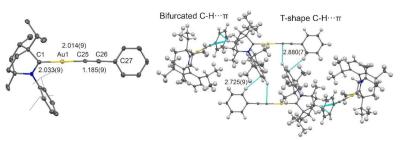Researchers from the University of Manchester, led by Prof. Alexander Romanov, developed a promising new Carbene-Gold-Arylacetylide (CMAc) OLED near UV emitter type. The researchers also detail a strategy to develop longer device lifetimes for such emitters.
The new emitter exhibits an efficiency of 1% EQE, and a lifetime of 20 minutes at a practical brightness of 10 nits (LT50). This is low compared to commercial OLEDs - but it is actually quite outstanding for such an emitter, and the researchers say that this is among the longest lifetimes for a near UV-OLED at a practical brightness ever reported. In addition, organic fluorescent and TADF emitters rarely exceed 1% EQE at practical brightness.
The researchers explain that in both phosphorescent and TADF emitters, the radiative lifetimes are relatively long, which leads to quick degradation, in deep-blue emitters, and even more so in UV emitters. In this work, the researchers use triplet-management to increase the device lifetime and achieve near-UV fluorescence. A host material, DPEPO or PPF, was used to purposefully quench the triplet excitons, allowing only the near-UV fluorescence from the singlet excitons to occur.
The researchers believe the triplet-management strategy can be further explored to achieve longer operating lifetimes for UV-OLEDs and that carbene-metal-acetylides (CMAc) materials are highly promising for stable emitters for UV-OLEDs, with further work looking to increase their stability.


